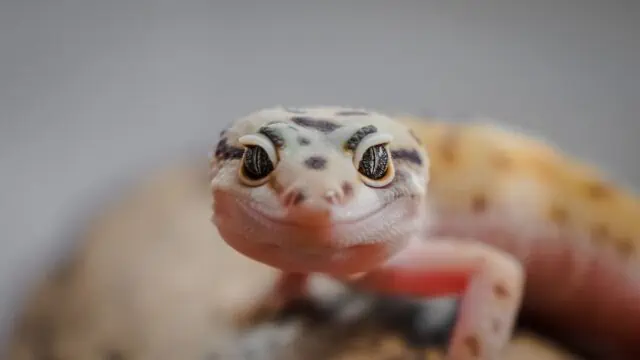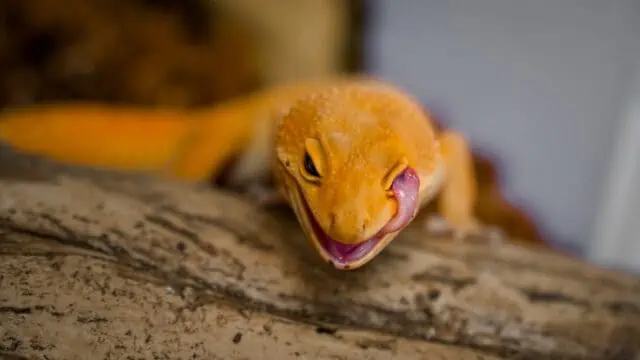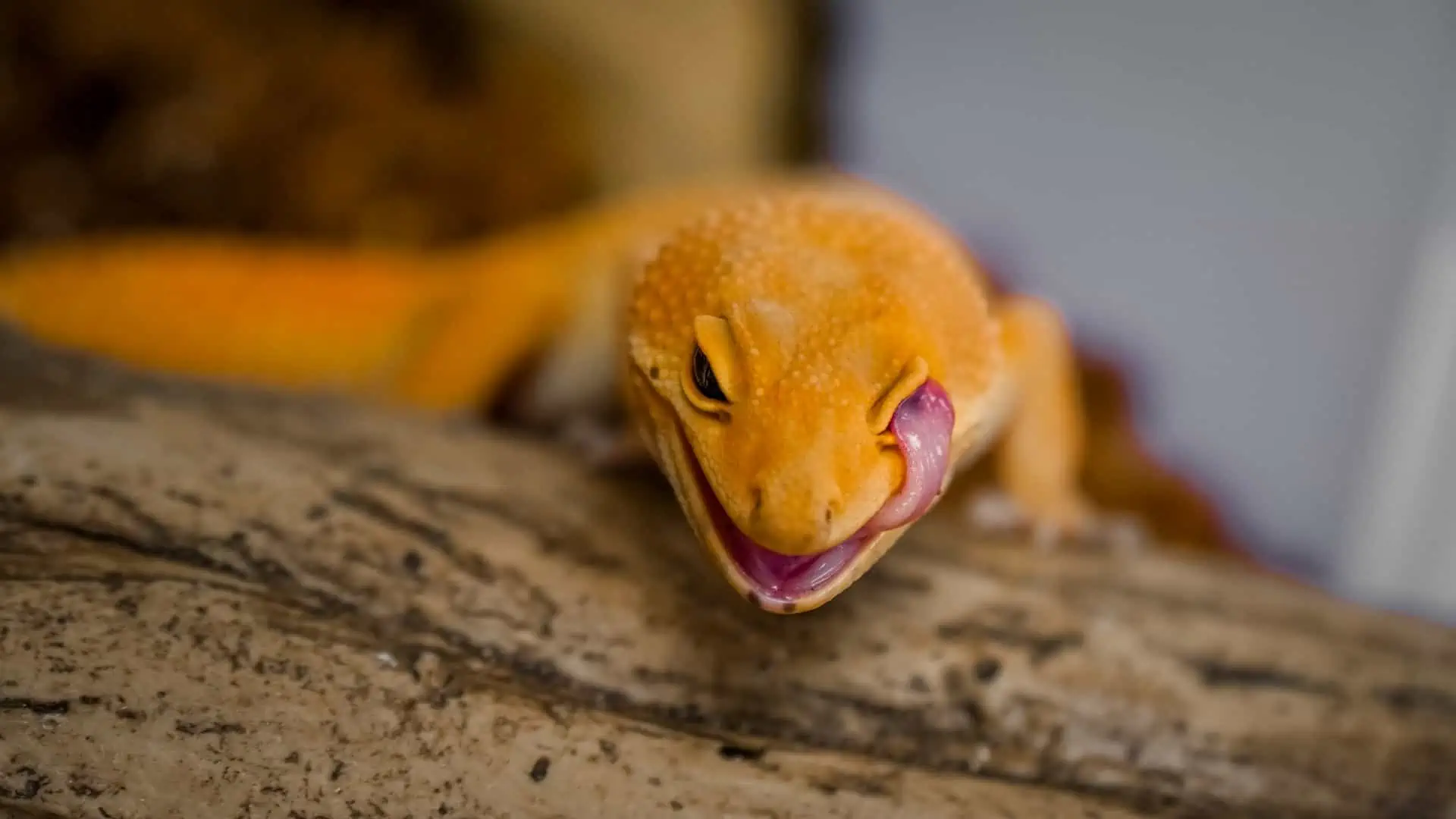Leopard Geckos can have eye problems for a variety of reasons, which range from environmental conditions to genetic factors. These small reptiles, known for their distinct patterns and large eyes, are susceptible to several eye issues. Proper care and attention are essential to ensure their eye health. Recognizing the signs of eye problems and seeking timely veterinary attention can help in addressing these concerns effectively.
Eye Health Importance: Leopard geckos are prone to various eye issues, often due to their large eyes and environmental factors. Regular checks can help detect issues early.
Preventive Care: Maintain a clean habitat with the right substrate and ensure a balanced diet. Avoid poor sanitation and non-selective breeding to reduce the risk of infections.
Common Issues: Bacterial infections, corneal ulcers, and congenital problems like microphthalmia and anophthalmos can affect their eyes. Recognizing symptoms early aids in timely treatment.
Treatment: Antibiotic eye drops, prescribed by a vet, are effective against bacterial infections. Ensure adequate UVB lighting and a nutrient-rich diet to bolster overall eye health.
Natural Cleaning: Leopard geckos use movable eyelids to protect against debris. They often rub their eyes against objects or use their tongues for cleaning, ensuring their eyes remain free from irritants.
Do Leopard Geckos Have Eye Problems?

Leopard geckos, with their large eyes, indeed face a series of eye problems. These creatures, admired for their vivid patterns, have eyes that are both a gift and a vulnerability. Due to the significant size of their eyes, they are particularly prone to various eye issues. Factors contributing to these problems often stem from environmental and dietary factors.
It’s crucial for pet owners to be aware of the common eye issues that leopard geckos can encounter. Some of these concerns might be minor, while others can escalate if not addressed promptly, and they could even lead to blindness for your leopard gecko. Regular monitoring and ensuring a suitable environment can prevent many of these problems. However, when issues do arise, it’s essential to provide proper care and seek veterinary attention without delay.
Common Eye Issues in Leopard Geckos
Leopard geckos, due to their distinctive eye structure, are susceptible to a range of eye-related problems. These issues can vary in severity and cause, but understanding them is key for effective care.
Bacterial Infections
Bacterial infections are among the prevalent eye issues that leopard geckos encounter. These infections can manifest in various ways, with symptoms such as redness, swelling, and discharge from the eyes. The causes often include contaminants in their environment or injuries that become infected.
Factors like unsanitary living conditions or exposure to other infected animals can elevate the risk of bacterial eye infections in leopard geckos. If left untreated, these infections can lead to further complications, affecting the gecko’s overall health and well-being.
For treatment, veterinarians typically prescribe antibiotic eye drops. These drops, when administered as directed, can effectively combat the infection. In some severe cases, other medications might also be recommended to ensure a full recovery.
Corneal Ulcer
A corneal ulcer is a distressing eye condition that leopard geckos can experience. It involves a break or abrasion in the outermost layer of the eye, often resulting from foreign bodies or trauma. Symptoms of a corneal ulcer in these reptiles include cloudiness in the eye, excessive tearing, and noticeable discomfort.
Typically, the presence of a corneal ulcer in leopard geckos is confirmed by veterinarians using a fluorescent dye. This dye adheres to the damaged area, making the ulcer clearly visible under specific lighting.
For treatment, it’s crucial to address the underlying cause of the ulcer. If a foreign object is responsible, it needs to be carefully removed. Veterinarians often prescribe specialized eye drops to promote healing and prevent infections. Along with the medication, regular follow-up check-ups are essential to monitor the healing process and ensure the gecko’s eye returns to its healthy state.
Congenital Issues
Leopard geckos, like many other species, can be born with congenital issues affecting their eyes. Some of the genetic abnormalities include conditions like microphthalmia (undersized eyes), cyclopia (a single eye located where the nose should be), anophthalmos (absence of one or both eyes), and fused eyelids.
These congenital deformities, while rare, can lead to various complications for the gecko. Ulceration, a result of abnormal eye structure rubbing against surfaces, can be a concern. Moreover, these deformities can also make the gecko more susceptible to infections and other vision problems.
A notable mention is the albino geckos. These lighter-colored hatchlings, due to their genetic makeup, are particularly oversensitive to bright lights. They often require special care to ensure their comfort and health.
Another congenital deformity is ankyloblepharon, where the eyelids are fused together. This condition often necessitates surgical intervention to separate the eyelids, allowing the gecko to see and function normally.
Ocular Discharge
Ocular discharge is a common concern among leopard gecko owners. This discharge, often seen as a wet or crusty substance around the eyes, can be indicative of various underlying issues. Causes range from minor irritations, like dust or debris, to more severe conditions like bacterial or fungal infections.
Addressing ocular discharge in leopard geckos promptly is crucial. If left untreated, what might start as a minor irritation can lead to more severe complications. Infections can spread, potentially affecting the gecko’s overall health and well-being.
For treatment options, the first step is identifying the cause. Cleaning the gecko’s environment and ensuring it’s free from irritants can resolve minor cases. However, persistent or severe discharge often requires medical intervention. A visit to a veterinarian can provide a proper diagnosis and a treatment plan, which may include eye drops or other medications.
Symptoms of Eye Problems in Leopard Geckos

Recognizing the symptoms of eye problems in leopard geckos is essential for timely intervention and care. These reptiles, with their prominent eyes, can exhibit various signs indicating an underlying eye issue.
Blurred Vision or Peripheral Vision Loss
Blurred vision and peripheral vision loss are alarming symptoms in leopard geckos. These symptoms can manifest as the gecko frequently bumping into objects, showing disinterest in hunting, or appearing disoriented. Common causes include bacterial infections, injury, or the presence of foreign substances in the eye.
Underlying health conditions, such as congenital issues, can also lead to vision problems. Additionally, poor living conditions, like improper lighting or unclean environments, can contribute to these issues.
Weight Loss or Painful Condition
Experiencing weight loss or displaying signs of a painful condition can indicate underlying health concerns in leopard geckos. These symptoms might manifest as the gecko eating less, becoming less active, or showing signs of distress when touched or handled. This can even manifest in a change of color, among others.
Several factors can contribute to these conditions. Poor living conditions, such as unsuitable temperatures or humidity levels, can stress the gecko, leading to weight loss.
Inadequate nutrition or a contaminated water source can also play a role. External environmental conditions, like exposure to toxins or harmful substances, can adversely affect their health.
Underlying health conditions, such as internal parasites or infections, can also lead to weight loss or pain.
Closed or Movable Eyelids
Closed or movable eyelids in leopard geckos are not just a unique trait but also an indicator of their eye health. These eyelids play a protective role, shielding their eyes from potential harm. However, if a gecko frequently keeps its eyes closed or shows difficulty moving its eyelids, it might signal an underlying issue.
One common reason for closed eyelids can be an injury to the eye or the presence of a foreign object. Such obstructions or trauma can lead to more severe complications like an eye ulcer or an abscess. Both conditions are painful and can severely affect the gecko’s vision if left untreated.
Symptoms owners should be vigilant about include swelling around the eyes, discharge, or the gecko’s inability to fully open its eye. If any of these signs are observed, seeking veterinary care is essential.
Flaky Skin or UVB Light Sensitivity
Flaky skin and UVB light sensitivity are two concerns that leopard gecko owners might encounter. Flaky skin, often observed as patches of dry, shedding skin, can result from poor shedding cycles or excessively dry conditions within the gecko’s habitat.
To remedy this, ensuring a balanced humidity level is crucial. Owners can introduce a moist hide or mist the enclosure lightly to aid in proper shedding and prevent skin issues.
On the other hand, UVB light sensitivity is observed when geckos seem agitated or stressed under UVB lighting. While UVB is essential for their health, excessive or direct exposure can be harmful.
It’s vital to provide a proper source of UVB lighting that isn’t too intense for the gecko. Additionally, offering shaded areas or retreats within the enclosure allows the gecko to escape direct exposure, ensuring they benefit from the light without the risk of oversensitivity.
Treatment for Eye Problems in Leopard Geckos
When it comes to leopard geckos, ensuring their eye health is of paramount importance. Given their susceptibility to various eye issues, understanding the treatments available is crucial for any owner.
Bright Lights and Proper Diet
For leopard geckos, the significance of bright lights and a proper diet cannot be overstated, especially concerning their eye health. Adequate UVB lighting not only aids in calcium metabolism but also plays a pivotal role in maintaining their vision. Insufficient or excessive lighting can lead to various eye issues, making the balance crucial.
Alongside lighting, a balanced diet ensures the gecko receives essential nutrients, further bolstering their eye health and preventing potential infections.
Antibiotic Eye Drops
Antibiotic eye drops are a vital tool in the arsenal for treating eye infections in leopard geckos. When these reptiles show signs of eye distress, it’s often a result of bacterial infections or conditions like conjunctivitis. In such cases, a veterinarian might prescribe these specialized eye drops.
The application process is straightforward but demands precision. Depending on the severity of the infection and the specific antibiotic prescribed, the frequency of administration can vary. Typically, the veterinarian will provide clear instructions on the recommended dosage and the number of times the drops should be applied daily.
How Do You Prevent Leopard Geckos From Getting Eye Infections?
Preventing eye infections in leopard geckos is a combination of proactive care and keen observation. One of the primary preventive measures is ensuring a clean and stable environment within their enclosure. This involves regular cleaning to remove feces, uneaten food, and shed skin, as well as selecting a suitable substrate that doesn’t irritate their eyes.
Hygiene is paramount, both in terms of the habitat and how the gecko is handled. Using sanitized hands or gloves when handling can prevent the transfer of harmful bacteria. Furthermore, providing a balanced diet ensures they receive the necessary nutrients to bolster their immune system.
Several factors can predispose geckos to eye infections. Poor diet, leading to weakened immunity, and poor sanitation can introduce harmful pathogens. Additionally, non-selective breeding can result in offspring with congenital vulnerabilities. Finally, inappropriate environmental conditions, such as incorrect humidity or temperature, can stress the gecko, making them more susceptible to infections.
How Do Leopard Geckos Keep Their Eyes Clean?
Leopard geckos have intriguing and effective ways of maintaining their eye hygiene. Unlike many reptiles, they don’t have a protective eye membrane or nictitating membrane. Instead, they rely on their movable eyelids to shield their eyes. These eyelids act as a barrier, preventing dirt, debris, and potential harmful agents from direct contact, offering substantial debris protection.
In their daily activities, leopard geckos exhibit behaviors to keep their eyes clean. It’s not uncommon to see them rubbing their eyes against objects in their environment, helping to dislodge any foreign particles. Additionally, they might use their tongues to clean their eyes, a behavior that aids in removing any dirt or irritants that might have settled on the eye surface.
Through these natural behaviors and their anatomical features, leopard geckos efficiently safeguard their eyes from potential infections and keep them in pristine condition.
Whatever you do, don’t wash the gecko to remove dirt from its eyes. Only bathe them for other types of dirt or for medical reasons.





